The insect pests one of the major constraints in successful cultivation of cole crops like cabbage and cauliflower include diamondback moth (Plutella xylostella) (DBM), aphids (Brevicornae brassicae and Myzus persicae), stem borer (Hellula undalis) and Spodoptera litura. The feeding damage by the pests spoils the quality of the head and renders unfit for human consumption.
To overcome the problems, ICAR-Indian Institute of Horticultural Research, Bengaluru’s concerted efforts for developing sustainable and safe integrated pest management strategies include the use of mustard as trap crop, application of neem soap and biocontrol agents, etc. The research to refine the technologies has resulted in developing the Neem Seed Pellet Powder Formulation (NSPPF). This is not only simple and economical, but also effective and environment-friendly in managing the major pests like DBM and aphids on cabbage and cauliflower.
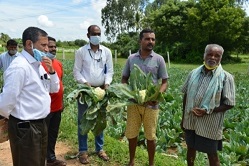
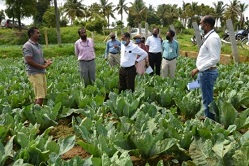
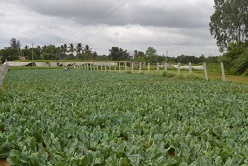
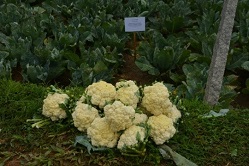
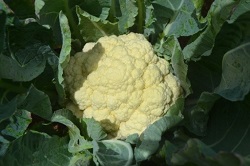
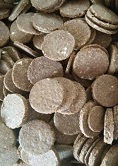
The NSPPF’s use does not require any additional application of insecticides. The technology has been successfully demonstrated to the farmers during the National Horticultural Fair held at the ICAR-IIHR, Bengaluru. Recently, the NSPPF technology’s demonstration was also carried out in a farmer’s field at Madappanahalli Village, Yelahanka Hobli, Bengaluru Rural District on Cauliflower Crop.
The crop was raised by the farmer, Shri Harish in an acre with technical inputs from the Entomologists of ICAR-IIHR.
Around 25 day old Cauliflower (hybrid: Dhaval) seedlings were transplanted on with a spacing of 45cm x 30 cm in 1.0 acre. The crop was given an initial dose of NPK@120:80:80. The drip irrigation facility was provided to the plot. First, NSPPF spray was given at 15 days after transplantation (DAT) at 6 Kg pellets / acre (200 L spray solution was required), subsequent sprays were at every 8 days interval. The sprays were given to meticulously cover growing tips of the transplanted seedlings.
Besides the experimental plot, there was also a plot where conventional pest management methods which mainly consisted of insecticide sprays were given which served as standard check to compare the results. The farmers mainly used chemicals like diafenthuron, dichlorovas, lambda cyhalothrin, indoxacarb, flubendiamide, spinosad, etc. The sprays were given almost at 3-4 days intervals.
Preparation of NSPPF for field sprays
- The NSPPF was soaked in water over the night a day before its application. The formulation was applied @ 6 Kg / acre (200 L spray solution).
- Next day before spraying, the extract was filtered through muslin cloth / net and the extracts’ volume was made up to the required level.
- The sticker @ 0.5 ml / L was added to spray solution and mixture sprayed on the crop.
- While spraying, care was taken to provide sufficient coverage on the growing portion of the plant.
- The spray was repeated every 7 to 8 day interval, up to 70 DAT. On an average, 7 to 8 sprays are required to the crop depending on the incidence of DBM and aphids. The need-based spray may be given if found necessary.
The harvesting was done 70 days after transplanting. The crop and application of NSPPF was regularly monitored by the Institute’s scientists. The weekly data on insect pest incidence on the ICAR-IIHR’s NSPPF Technology field and chemical field was recorded.
Impact of Technology
- The technology has significantly reduced the number of sprays given from 20 applications in conventional practice to 7 to 8 using the NSPPF. This has resulted in significant saving in the cost of chemicals and labor. By using the current technology, 20 sprays of chemical insecticides were brought down to 7 to 8 sprays by the NSPPF.
- The incidence of DBM was found to be 0.4 DBM / plant on NSPPF treated crop which was at par with chemical treated crop (0.3 DBM / plant).
- The farmer was spraying with different combinations of synthetic insecticides at every 3 to 4 day interval and about 18 to 20 sprays were given for the entire cropping period.
- He incurred the expenditure of Rs. 35,000/- towards purchase of insecticides for covering 0.5 acre of cauliflower for managing DBM and aphids.
By adopting ICAR-IIHR’s NSPPF technology he saved Rs. 25000/- that was otherwise spent on chemical insecticides. Application of NSPPF was economical, with an expenditure of only Rs. 9,000/- sufficient for the entire cropping period. - The produce was marketed per individual curd basis, consumer preferred more to NSPPF treated curds for good quality, pesticide residue free, with an average weight of 1.20 Kg / curd over synthetic insecticide treated ones (average 0.9 Kg / curd of poor quality).
- The farmer earned a profit of Rs. 98,000/- from 0.5 acre of cauliflower by adopting ICAR-IIHR’s Neem Seed Powder Pellet Formulation
- Technology. While following the chemical management practices, he has earned around only Rs. 55, 000/- profit.
- The B:C ratio for NSPPF field was around 4.58 compared to 2.10 in case of chemical pest management.
- The net gain of Rs. 43,000/- was mainly due to reduction from plant protection (insecticide) cost and higher remuneration from the pesticide free produce.
- The residue analysis of curd was made at different stages of crop growth at ICAR-IIHR showed no trace of residue of NSPPF on cauliflower heads.
The Institute’s Neem Seed Powder Pellet Formulation, thus, boosts the vegetable growers’ farm income by drastically cutting the cost of crop protection. Besides, it’s an eco-friendly approach that involves no use of synthetic chemicals, therefore, encourages beneficial insects with no harm to soil, environment and no residue on final produce of the crop.
(Source: ICAR-Indian Institute of Horticultural Research, Bengaluru)







फेसबुक पर लाइक करें
यूट्यूब पर सदस्यता लें
X पर फॉलो करना X
इंस्टाग्राम पर लाइक करें